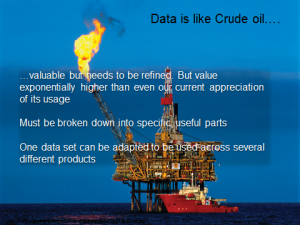Rami Karjian of Flextronics casually threw out the comment that “data is the new oil” during a session at the recent Gartner Supply Chain Conference in Palm Desert. The session titled “New Business Rules – The Flextronics Next-Generation Supply Chain Strategy” was hosted by GT Nexus. Given Flextronics' role as a contract manufacturer in the high-tech/electronics supply chain space, with aspirations of providing supply chain managed services, it is immediately obvious how they can make very effective use of data, especially extended or "true" end customer demand data and "true" component availability data. Of course, this is true for any number of participants in the supply chain and there has been a lot written about the use of social platforms to capture ‘big data’ on consumer behavior. But anyone who has worked with the likes of Flextronics will recognize that the ‘speed’ of their business (driven by low margins, high volumes, and rapidly changing products) is like no other. Knowing sooner and acting faster are core capabilities and competencies they must have in order to survive. It is easy to see where data fits into this equation. But I hope Rami will not be upset with me when I state that the term seemed too catchy to have come from a supply chain guy (I am writing as a supply chain guy, so I mean no disrespect!) The catchiness of the phrase just reeks of Analyst or Strategy Consultant. So I went Googling for the term. I was correct. The term seems to have been used originally by Andreas Weigend of Stanford in an interview with Forbes dating from September 2011. (One caution: The interview is sponsored by SAP.) In the interview Weigend says, with my emphasis, that
“Most people try to play the social media game faster, but it is not your game to play anymore. To be successful, you have to understand what the game is made of . . . it is data and identity. This forces the change from a transactional economy to a relationship economy. The companies who get this, will win.”
There is no doubt that Weigend is referring to the customer or demand side of the supply chain, really to ‘big data’ epitomized by social media platforms such as Facebook and Twitter. But here is the problem for social media: Customers aren’t compelled to engage in any manner with the OEM; Suppliers are. So while undoubtedly social data can be mined for information, social data cannot be relied on as the sole source of information to drive the business. Instead, social data can be used to augment, to enhance, the structured data that is being used to drive the business. I was struck by what Ray Wang said in this context in the same Forbes interview, namely that
“The market has moved beyond just marketing, service, and support use cases,” says Wang. “We see 43 use cases that span across key enterprise business processes that impact eight key functional areas, from external facing to internal facing including PR/marketing, sales, service and support, projects, product life cycles, supply chain, human capital management, and finance.”
Companies will get real value within the internal and supply sides from platforms that are social in nature, whereby social concepts will finally make collaboration a reality by adding context and nuance to ‘dumb’ EDI exchanges of data between computers. The activities of cross-functional and cross-organizational exploration and discovery through what-if analysis followed by negotiation, which are so important to decision making processes. These capabilities, which are required for decision making are not supported by EDI and ERP platforms, which instead focus on executional or transactional processes. This point was made very strongly at the Gartner Supply Chain Conference by Jim Cafone of Pfizer who said that
“ERPs are great if you want to talk to yourself, but who can afford to do that in today’s value chains?”
Jim was referring to the fact that much of today’s value/supply chain exists outside of the four walls of the organization because so much of the supply chain has been outsourced leading to the conclusion (using the context of ‘data is the new oil’, that ERP is like crude oil) - it needs to go through refinement and to be augmented by additives to be useful. It needs to be refined and augmented because, in order to operate a value/supply chain effectively today, it is necessary to reach across functional and organizational boundaries even for so-called structured data, making even structured data ‘big data’. As Jim Cafone stated, without reaching across the organizational boundaries, you are only ‘talking to yourself’. We cannot operate today’s supply chains effectively with this lack of visibility. (And let’s face it, many ERP deployments resemble an oil spill – the mess you’re in isn’t what you expected, and it’s going to cost an awful lot to fix.) To be of any value, the data provided by visibility needs to be ‘refined’ by being broken down into ‘specific useful parts’, turning visibility into actionable insight. I don’t mean to diminish the value of visibility because without it there can be no actionable insight. The true value comes from the supply chain orchestration made possible by actionable insight. So let us decompose ‘actionable insight’ quickly.
Turning Data into Visibility
Existing social network platforms, such as Facebook, are principally about sharing or “pushing” information, but most business processes require an interaction between at least two people, each of which is responsible for an aspect of the decision and who need to reach a consensus and compromise in order to take action. Often these interactions require input from as many as 5-10 people. Identifying who needs to know can often be an insurmountable barrier to reaching a timely decision. I want to draw the distinction here between the people who need to know, which implies responsibility to take action, and the people who want to know, which implies an interest but not a responsibility. Existing social technologies address the ‘want to know’, but not the ‘need to know’ aspect. On the other hand, existing machine-to-machine exchanges of structured data between organizations are desperately in need of the context and nuance provided by social platforms. Having both turns data into visibility.
Turning Visibility into Insight
Knowing the state of something – inventory, capacity, etc. – in the supply chain, which is what visibility provides, is useful, but not valuable. Value is derived from knowing what that state means to your financial and operational metrics, and, perhaps even more importantly, to your projected operational and financial metrics. To achieve this insight you must be able to compare the current state to a desired state and to evaluate if the difference is important, which you can only determine by having a complete representation of your supply chain – BOMs, routings, lead times, etc. – so that you can link cause to effect. You cannot do this by ‘talking to yourself’. Only if you have and end-to-end representation of your supply chain can you link a tsunami in Japan to your revenue projections for the next 2 quarters. Of course many people can do this given enough time. Doing this quickly – knowing sooner and acting faster – is what brings value. While events as large as the Japanese tsunami make the linkages between the supply chain nodes obvious, the daily operation of a supply chain is subjected to thousands of little ‘tsunamis’, the compounded effect of which, in terms of reduced revenue and increased costs, can often be the difference between making or missing a quarter.
Turning Insight into Actionable Insight
Knowing that something is not quite right – visibility – and knowing the financial and operational impact or consequence of this mismatch – insight - is only valuable if you can act on this insight quickly – actionable insight. To do this you must be able to link the impact to the person responsible for the impact, not only the cause. People take action. Of course under certain circumstances decisions can be automated, but only mundane decisions, decisions that make little difference, can be automated. ‘Big’ decisions should always be left to human judgment. And to do that we need to link the cause and effect to the people who need to take action. Hence actionable insight.
Turning Actionable Insight into Orchestration
Supply chain is a ‘team sport’. Each function may have their own span of control and metrics, but any decision made by one function will almost always have an impact on at least one other function and more likely have multiple impacts on multiple functions. But currently, each node in the supply chain, in fact each function in the supply chain, usually operates in isolation with Engineering making design changes with little thought as to how these impact Manufacturing or Procurement, with Marketing planning promotions with little consideration of available capacity or material availability, with Sales accepting order quantities and delivery dates with little consideration of the cost required to achieve both. Orchestration is the coordination and synchronization of these separate functions into a unified response to real demand. To achieve orchestration requires a platform on which a team of people across functional and even organizational boundaries can explore and understand the financial and operational consequences of possible actions quickly and collectively.
Turning Orchestration into Competitive Advantage
Too often when I write about these topics I forget to include the word ‘projected’. Without a doubt a great deal of value can be derived from risk recovery, but risk avoidance and risk mitigation are even more valuable. Being able to determine that revenue or margin targets will (future) not be achieved by the end of the quarter if we continue to create in the current manner is a lot more valuable than being able to determine why we have (passed) missed the quarter. Knowing sooner that something will happen if we do not change course allows us time to investigate ways to avoid the risk or to take the opportunity. But knowledge without action brings little benefit. I have written in the past about George Stalk’s concept of Competing Against Time and the related OODA concept – Observe, Orient, Decide, Act – idea from the US military strategist Colonel John Boyd, both of which explain very crisply the competitive advantage of knowing sooner and acting faster.







Leave a Reply